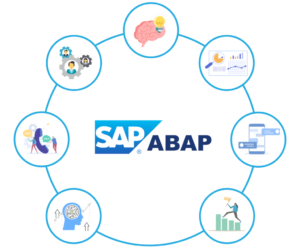SAP ABAP
The German software company SAP SE developed a high-level programming language called SAP ABAP, or Advanced Business Application Programming. In the SAP environment, ABAP is mostly used for creating customized reports, interfaces, enhancements, and forms.
Here are a few crucial elements of SAP ABAP:
- Data Dictionary: Data kept in the SAP system is frequently interacted with by ABAP programs. Developers can define and manage the data structures (tables, views, data components, and domains) used in the SAP system with the help of the Data Dictionary tool in ABAP.
- ABAP Workbench: SAP offers an integrated development environment (IDE) called ABAP Workbench, which is used to create ABAP applications. It comes with a number of tools, including Screen Painter, Data Dictionary, and ABAP Editor.
- Reports: Custom reports that pull and present data from the SAP system are frequently created using ABAP. Reports are frequently utilized for decision-making and corporate intelligence.
- Enhancements: With enhancements, SAP applications can be altered and expanded. Without changing the original source code, developers can add new code to ordinary SAP programs thanks to ABAP.
- Forms: SAP script and Smart Forms, which are used to create print layouts for various business documents, are forms that are developed using ABAP.
- Object-Oriented Programming (OOP): Classes and objects can be used by developers to create more modular and maintainable code because ABAP supports OOP concepts.
- ALV (ABAP List Viewer): ABAP has capabilities for producing interactive lists and reports, such the ALV (ABAP List Viewer). When tabular data needs to be displayed with multiple formatting possibilities, the ALV grid is frequently utilized.